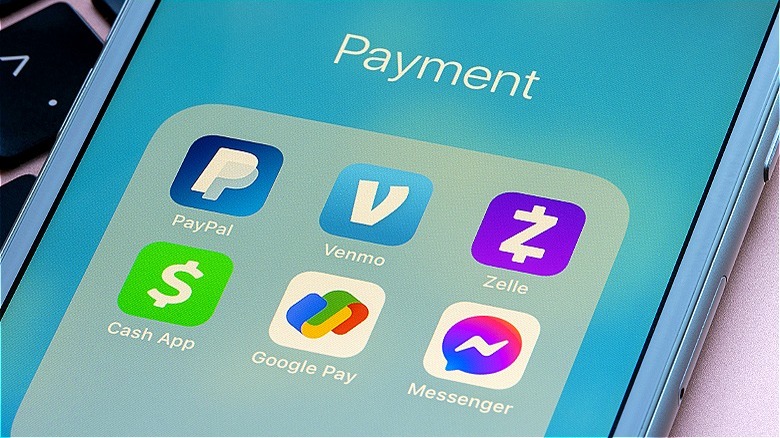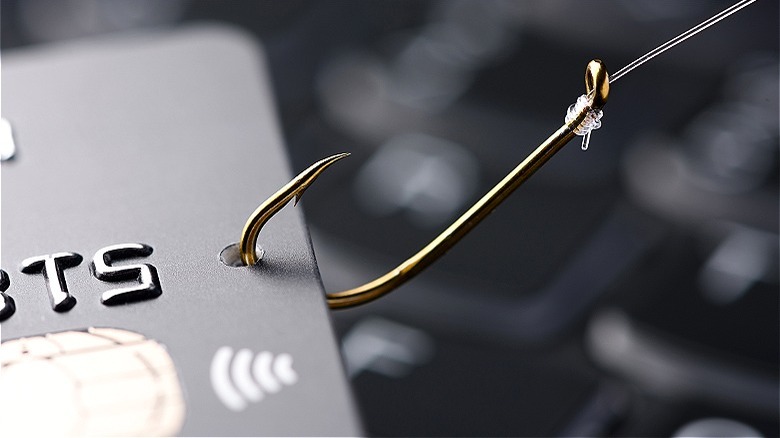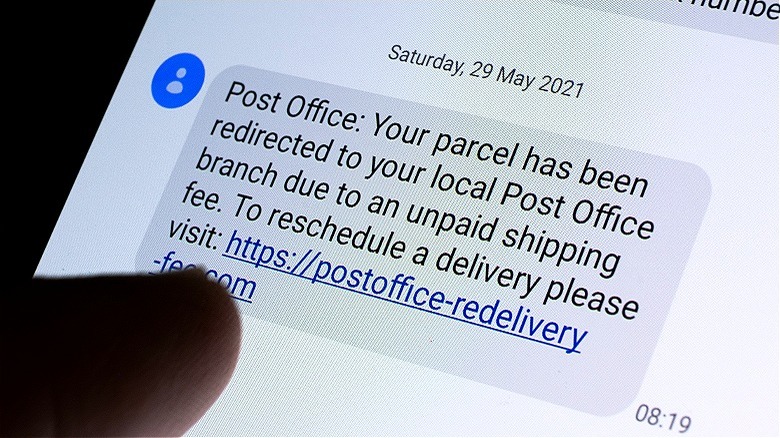Money Scams To Watch Out For In 2024
New year, new scams. While most Americans already have enough to worry about between high- interest rates, housing prices, and inflation, they should also be wary of new financial scams in 2024. Consider, according to the Better Business Bureau's annual BBB Scam Tracker Risk Report from a year ago, there were 40,503 incidents of scams reported in 2022. Even worse, the median monetary loss resulting from the scams was $171. As technology makes it easier for fraudsters to create more complicated and seemingly legitimate scams, it can be increasingly difficult to tell the difference between what's real and what's a scam.
Further, it's also impossible to discount the impact the internet has had on scam scenarios. Online scams are far more likely to result in reported monetary loss than scams perpetrated via the phone or even in person. This makes it increasingly important to verify your internet activity and to ensure you're visiting (and purchasing from) legitimate websites. For anyone thinking online scams only target older generations, the BBB 2022 Online Scams Report found that consumers aged 18 to 24 had the highest scam-related median dollar loss of all age groups.
Also, per the BBB's numbers, 47.5% of scam victims reported losing confidence and/or peace of mind after they were targeted by a scam, so making sure to stay vigilant can be the key to avoiding not only financial hardships but also emotional ones. While there are a lot of different scams to be aware of, here are a few particularly concerning ones you should make sure to avoid in 2024.
Artificial intelligence scams
Artificial intelligence has made money scams more complex than ever. From AI-generated voice impersonation to AI-generated text and email content, the chances that the scammer directly trying to target you is an actual person is increasingly less likely. However, while computer-generated text has traditionally been clunky and obviously fake in the past, recent advancements in AI technology have made phishing emails, text messages, and even robocalls more natural sounding and realistic. This makes it more likely to convince potential victims of the scam's legitimacy. What's more, since it's cheaper and more efficient for scammers to deploy AI tactics that can target more people in the same amount of time as a single person, it allows the scammers to target even more people than before.
Another concerning element of AI-powered scams is a scammer's ability to create seemingly real visual content. Deepfakes and AI-generated photos have the potential to make fake organizations, causes, and scam scenarios actually seem legitimate. For example, creating deepfake videos and/or audio of celebrities or other trusted individuals can trick fraud victims into investing or donating to a company, project, or cause. These fake videos, images, and audio recordings can take advantage of an existing person's social legitimacy to create legitimacy for a project that is, in fact, a scam. The advanced nature of the technology makes these scams incredibly believable, which puts consumers at a higher risk of becoming victims of fraud. False content is especially prevalent on social media, so making sure to be mindful about the source of any content, testimonial, or ad you're seeing is vital.
Peer-to-peer (P2P) payment app scams
While peer-to-peer apps, such as Zelle, Venmo, and Cash App, have made our lives easier in many ways, they've also, unfortunately, led to rampant fraud and scam attempts. Some of the most popular ways scammers use these P2P apps to get money from potential victims seem harmless at first. For example, a popular scam involves someone "accidentally" sending you money via your P2P service before requesting the money back. According to the FBI, the accidentally sent funds are often stolen, which could leave you liable for the amount should you send it back before the P2P service flags the funds and exchange. If you're the recipient of "accidentally" sent funds, it's best to contact your P2P service rather than sending any funds back yourself.
In addition to the dark sides of P2P apps like Venmo you should know about, Consumer Reports in 2023 also issued a warning to consumers using P2P apps. Namely, the consumer organization called out the lack of user protections and regulations in most P2P apps. Delicia Hand, director of financial fairness for Consumer Reports, explained that "... the regulatory vacuum around these new tools has allowed potentially unfair, unsafe, and discriminatory practices to spread unchecked." This means that most P2P apps today fail to help, intervene, or compensate users to reclaim money lost to scams while using the app. Similarly, user agreements for the largest peer-to-peer apps force consumers to agree to binding arbitration as opposed to traditional court proceedings, a legal tactic that prevents consumers from joining together for lawsuits against these companies.
Online purchase scams
According to the BBB, 76.3% of all scams that led to consumer monetary losses were the result of online purchase scams. Its research also found that 56.5% of all scams reported in 2022 were online purchase scams, making them the most prevalent and riskiest of all scam types for consumers. Part of this is because a lot of different scams exist across the internet. Note that the most reported scammer contact methods that led to monetary loss include fraudulent websites (48.2%), email scams (17.5%), and social media (16.8%), while the contact methods that led to the highest monetary losses involved other forms of communication. Per the BBB's risk report, consumers lost a median of $800 via text message scams, $308 from online messaging apps, and $207 from false online classifieds.
According to the Federal Deposit Insurance Corporation, scammers can use a multitude of tricks to scam their victims. For starters, many create entirely fake websites that look and operate similarly to popular websites. This allows scammers to take your personal and financial information easily while you wait for an order that's never coming. Similarly, fake apps can use malware. By downloading an app with malware, you might inadvertently allow your personal or financial information to be stolen by scammers. This can include access to your social media accounts, your address, and credit card information. Some scammers might even lock you out of your device as a way to essentially hold your phone hostage until you pay a ransom.
Employment scams
Employment scams were the second-riskiest money scam type overall in 2022, and for the first part of 2023, the Better Business Bureau claimed employment scams were up by 250%. What can make a potential job scam so believable is the level of detail scammers go to in order to appear legitimate — from professional websites to top results on Google searches to realistic-looking ads on social media, employment scams can be especially difficult to detect. This said, there are a few common different ways an employment scam can happen. Some companies, for example, might charge you upfront for necessary "training" or even equipment and/or supplies to work from home. Others might ask you to provide personal and/or banking information after being hired to either run a credit check or set up direct deposit.
Given the current economic climate in the United States, it's also an especially easy time for such scammers to find potential victims. Many of us would love the opportunity to increase our wages to offset things like inflation and housing costs, so it's no wonder that, in 2022, job scams became the riskiest scam type for people aged 18 to 34. With all this in mind, note that 68% of BBB surveyed scam victims reported not ever asking for verification of employment from the representative they were talking to. However, even when scammers were asked to verify, many utilized fake business cards, video calls, or even offered up their supervisor's phone number all in the hopes of proving their legitimacy.
Impersonation scams
Impersonation is the most common tactic used to perpetrate scams, according to the Better Business Bureau's research. Further, within this type of scam, pretending to belong to or be a representative of an existing, legitimate organization was the most reported tactic used (54%). In 2021 and 2022, the BBB Scam Tracker found that Amazon was the most impersonated organization, with Geek Squad, Publisher's Clearing House, the U.S. Postal Service, and Norton software rounding out the Top 5 of notable organizations scammers claim to be. Scammers use the name recognition and the authority of these organizations to their advantage, by appearing legitimate to their would-be victims. Beyond impersonating company representatives, scammers can also impersonate government agencies, like the IRS or Social Security, in addition to impersonating tech or security support, charities, or even your grandchild or other relative.
The BBB reports the median monetary loss due to financial scams is the lowest for those who paid by credit card, at $89. This is noticeably lower than other payment methods like, say, wire transfers, which resulted in a median monetary loss of $2,700, or checks at $1,277. Since credit cards typically have stronger consumer protections as well as fraud alerts, consumers are more likely to recoup their lost or stolen funds if the purchase was made with a credit card. While it won't offer you complete protection, if you're ever in doubt about the validity of a purchase, opting to use a credit card could end up helping you in cases of scams.





